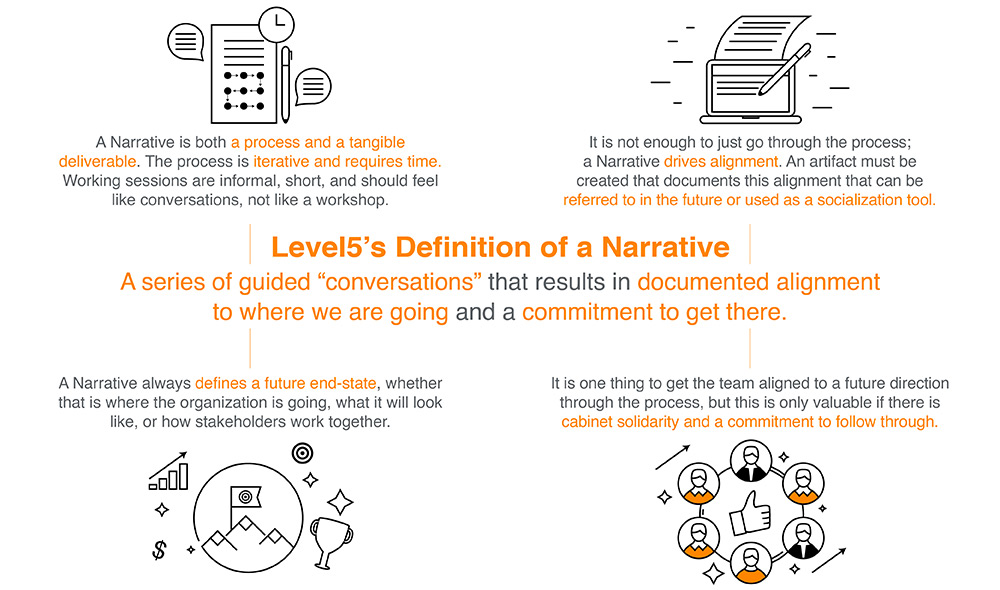
Article
The Best Plans Start At The End: Starting with the Destination Creates More Actionable, Transformative Plans
Efram Lebovits, Claude Ricks, James Hunter — January 21, 2021
During strategic planning, companies often spend the majority of their time focusing on how they’ll achieve their goals. When focusing on “how”, leaders often end up talking more about the challenges they may face, the concerns they have, and the limitations they need to consider rather than the outcomes they hope to deliver. This leads to uninspiring, conservative plans that lack strong buy-in.
Companies who hope to achieve truly inspiring and transformative plans need to re-sequence how they traditionally approach strategic planning. Absolute clarity on what the company wants to accomplish over the strategy horizon, as well as where the company will be and what the company will look like is required to then clearly and effectively define “how” the organization will get there.
Early (& meaningful) engagement = Increased Success
All too often, we heard that clients had previously struggled to gain alignment to their strategic plan and the solidarity required for implementation.
This led to an important insight – strategic planning needs to be looked at as an important process with multiple outcomes (alignment, a Narrative, etc.), not just a critical document: the strategic plan. Purposefully engaging cross-functional leaders (both C-Suite and Upper Management, and, in some cases, Board Members) during the planning phase helps companies achieve the clarity and commitment required to successfully define and deliver a transformative strategic plan.
Ambitious end-state goals inspire and excite all stakeholders. By collectively sharing a common goal and vision of success the group’s commitment to follow through on the plan – that they helped to create – increases exponentially.
Level5’s Narrative is both a process and a tangible deliverable
We develop Narratives – a written, forward-looking account of what the company looks like, what it’ll feel like, and what employees and customers will see at the end-state – through a facilitative and iterative process that builds leadership alignment and ownership of the plan. There’s no pressure to get things right off the bat. In fact, working sessions are intentionally kept short so we can maintain energy and engagement. These sessions feel like a series of guided conversations to build comfort and make participation more accessible.

While conversations feel relaxed, all strategies are data-driven. We leverage a common, bottom-up fact-base to ensure we’re defining goals that align with the company’s context and value drivers. This fact-base generally includes key Category, Company, Customer, Consumer (if different from Customer) and Competitive insights. Strategic planning shouldn’t be a navel gazing exercise, it should be inspiring, ambitious, and based on growth-driving insights.
As part of our Narrative development, we go through a series of scenario exercises. Scenarios reflect the different value levers that an organization has. During scenario workshops, we break down conservative thinking by challenging ourselves to say “What if we were world-class” at each scenario (e.g. the most customer-centric organization). This process helps leaders uncover opportunities for innovation and step-change growth.

After figuratively dialing each scenario to their maximum, we engage Board Representatives and Senior Executives to find the ideal ‘balance’ of scenarios. This top-down guidance creates alignment between those governing where the organization is going and those accountable to deliver.
The company’s goals and alignment are then captured via an artifact: a robust Narrative that clearly outlines the company’s ideal scenario mix in prose. A Narrative helps to increase leaders’ understanding of the plan and organizational goals. It also helps ensure that all leaders are on the same page regarding the company’s long-term goals; this stands opposed to a simple Vision statement that can easily be interpreted in several ways. We’ve found that short, engaging stories are a great tool for alignment-building and bring stakeholders into the fold. It also helps achieve the Board’s support and gain wide-spread organizational understanding of the company’s strategic direction.
In closing
Our approach to Narratives provides a clear, yet flexible vision of the company’s strategic goals and direction. It helps leaders gain a common understanding of what the company is trying to accomplish. Ultimately, a Narrative-led approach ensures that leaders channel their attention on what’s really at stake: their company’s ideal end-state, not conservative thinking that leads to uninspired plans.
By gaining wide-spread alignment to the company’s long-term goals and direction, we create a solid foundation for completing the Strategic Plan: outlining how the company will achieve that desired state, the ‘How’. Executives and Senior Management are much more effective in determining how they can best action against the aligned-to goals because the end-state is fully outlined in the Narrative. Without that foundation, companies risk developing plans that lead to misaligned or unclear goals.
Authors
For more information, please contact:
Claude Ricks at cricks@level5strategy.com
Level5 Strategy is a leading strategy and transformation consulting firm that delivers sustainable growth even amid challenging times such as the COVID-19 pandemic. Connect with us to discover how Level5 Strategy can help you drive profitable ROI through strategy and transformation.




